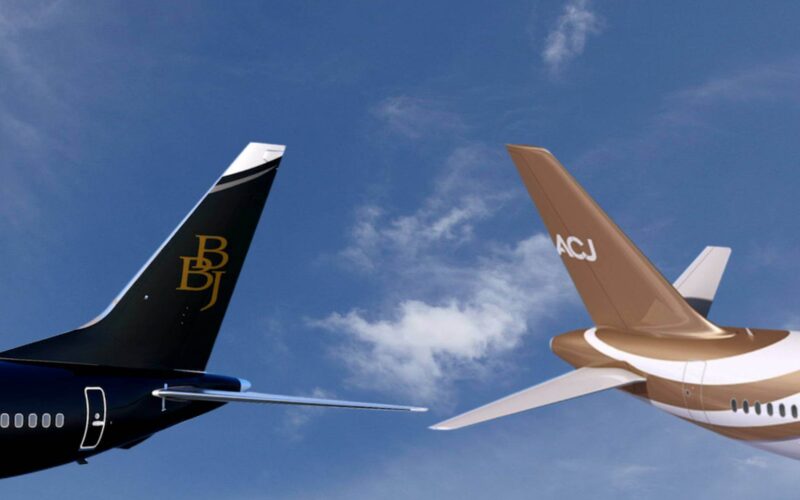Airbus and Boeing, the world’s two biggest aviation manufacturers, are locked in tight competition. Pretty much every model of aircraft each of them manufactures has a rival made by the other company.
One of the areas the firms compete in is business jets – aircraft aimed at private customers who are willing to shoulder their immense price.
Each model Boeing produces has a business jet (BBJ) variant, with the business variant of the 737-700 called simply BBJ. The 737-800 and the 737-900ER are named BBJ2 and BBJ3 respectively, while wide-body business jets retain the names of their base passenger variants: the BBJ 787-8, the BBJ 787-9, the BBJ 777-8, the BBJ 777-9, and the BBH 747-8. In addition, Boeing’s latest generation of the 737 has three bizjet variants: the BBJ 737 MAX 7, the BBJ 737 MAX 8 and the BBJ 737 MAX 9.
Airbus calls the aircraft it manufactures for private owners Corporate Jets (ACJ). Its line-up mirrors that of Boeing: the narrow-body A318, A319, A320 and A321 have their respective corporate monikers – ACJ318, ACJ319, ACJ320 and ACJ321, while business variants of the wide-body A330, A340 and A350 XWB are the ACJ330, ACJ340 and ACJ350 XWB.
Since 2010, aircraft of the A320 and A330 families with newer CFM or Pratt & Whitney engines are designated ‘neo’, while non-reengined aircraft have the ‘ceo’ designation added to their name. In addition, in 2023 Airbus is set to debut the ACJ TwoTwenty – the business jet variant of its latest A220 narrow-body airliner.
So, how do both companies fare in comparison with each other? The graph below shows the deliveries of all Airbus and Boeing business jets (BBJ and ACJ). The data from quarterly shipment reports by the General Aviation Manufacturers Association (GAMA) was used, supplemented by the reports of the manufacturers themselves.
The graph shows several interesting trends. Firstly, the business jet market is a lot more unstable than the commercial aircraft sector. In the latter, deliveries and orders fall and rise slowly. In the former, the number of orders can fluctuate wildly – for example, Airbus sold more than double the number of business jets in 2015 than in 2016.
Secondly, the numbers of business jets the two giants deliver is actually quite small in comparison with their total output. Both companies count their total deliveries in hundreds (each company delivered more than 800 aircraft in 2018, for example), while the deliveries of business jets barely reach a dozen a year each at best.
Nevertheless, we can see that, for most of the past decade, Boeing dominated the race – only to fall from grace in 2019 when the 737 MAX crisis kicked in. Its full scope and the consequences for business jet sales is revealed in the following graph:
For both manufacturers – Airbus even more so than Boeing – narrow-body jets (BBJs of the 737 family and ACJs of the A320 family) constitute most of the deliveries. In 2012 and 2017, Boeing delivered more wide-body business jets than narrow-body ones, but the overall trend is clear. In 2019 the deliveries of the 737 MAX stopped, barring Boeing from selling narrow-body BBJs.
2020 brought its own difficulties: the pandemic brought most international travel to a halt, and commercial sales of wide-body jets plummeted. For some reason, that had an effect on the wide-body business jet market as well, although Airbus managed to deliver two large ACJs nonetheless.
But one further bit of context has to be kept in mind. While Airbus and Boeing are undeniably the largest aircraft manufacturers in the world, their business jet arms form a small part of their businesses. In terms of BBJ and ACJ deliveries, the two companies fall far behind the firms that specialize in the manufacturing of business jets – such as Dassault, Embraer and Gulfstream.
To highlight that, here is a chart comparing the total deliveries of the five companies in the second half of the last decade.
Why are the numbers so small? The answer is simple – the line-up of Airbus and Boeing business jets is very different from the regular bizjet manufacturers. Airbus and Boeing’s smallest jets are significantly bigger than the largest ones offered by Embraer, Dassault and Gulfstream.
The size reflects the price. So, Airbus and Boeing cater to the very top of the business jet clientele, and stand out from the rest of the market that way. When it comes to the wide-body business jet market, there is simply no alternative to the two giants, which is why they are an important – even if numbers-wise quite small – part of the business jet market

